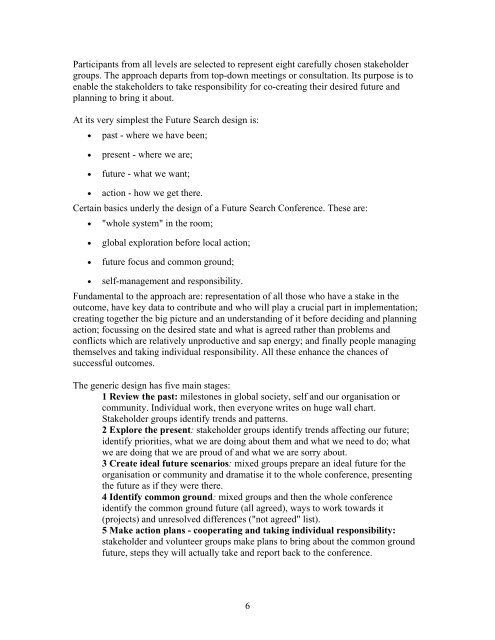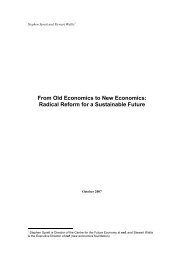Creating the futures we desire - getting the whole ... - Bruce Nixon
Creating the futures we desire - getting the whole ... - Bruce Nixon
Creating the futures we desire - getting the whole ... - Bruce Nixon
You also want an ePaper? Increase the reach of your titles
YUMPU automatically turns print PDFs into web optimized ePapers that Google loves.
Participants from all levels are selected to represent eight carefully chosen stakeholder<br />
groups. The approach departs from top-down meetings or consultation. Its purpose is to<br />
enable <strong>the</strong> stakeholders to take responsibility for co-creating <strong>the</strong>ir <strong>desire</strong>d future and<br />
planning to bring it about.<br />
At its very simplest <strong>the</strong> Future Search design is:<br />
• past - where <strong>we</strong> have been;<br />
• present - where <strong>we</strong> are;<br />
• future - what <strong>we</strong> want;<br />
• action - how <strong>we</strong> get <strong>the</strong>re.<br />
Certain basics underly <strong>the</strong> design of a Future Search Conference. These are:<br />
• "<strong>whole</strong> system" in <strong>the</strong> room;<br />
• global exploration before local action;<br />
• future focus and common ground;<br />
• self-management and responsibility.<br />
Fundamental to <strong>the</strong> approach are: representation of all those who have a stake in <strong>the</strong><br />
outcome, have key data to contribute and who will play a crucial part in implementation;<br />
creating toge<strong>the</strong>r <strong>the</strong> big picture and an understanding of it before deciding and planning<br />
action; focussing on <strong>the</strong> <strong>desire</strong>d state and what is agreed ra<strong>the</strong>r than problems and<br />
conflicts which are relatively unproductive and sap energy; and finally people managing<br />
<strong>the</strong>mselves and taking individual responsibility. All <strong>the</strong>se enhance <strong>the</strong> chances of<br />
successful outcomes.<br />
The generic design has five main stages:<br />
1 Review <strong>the</strong> past: milestones in global society, self and our organisation or<br />
community. Individual work, <strong>the</strong>n everyone writes on huge wall chart.<br />
Stakeholder groups identify trends and patterns.<br />
2 Explore <strong>the</strong> present: stakeholder groups identify trends affecting our future;<br />
identify priorities, what <strong>we</strong> are doing about <strong>the</strong>m and what <strong>we</strong> need to do; what<br />
<strong>we</strong> are doing that <strong>we</strong> are proud of and what <strong>we</strong> are sorry about.<br />
3 Create ideal future scenarios: mixed groups prepare an ideal future for <strong>the</strong><br />
organisation or community and dramatise it to <strong>the</strong> <strong>whole</strong> conference, presenting<br />
<strong>the</strong> future as if <strong>the</strong>y <strong>we</strong>re <strong>the</strong>re.<br />
4 Identify common ground: mixed groups and <strong>the</strong>n <strong>the</strong> <strong>whole</strong> conference<br />
identify <strong>the</strong> common ground future (all agreed), ways to work towards it<br />
(projects) and unresolved differences ("not agreed" list).<br />
5 Make action plans - cooperating and taking individual responsibility:<br />
stakeholder and volunteer groups make plans to bring about <strong>the</strong> common ground<br />
future, steps <strong>the</strong>y will actually take and report back to <strong>the</strong> conference.<br />
6



